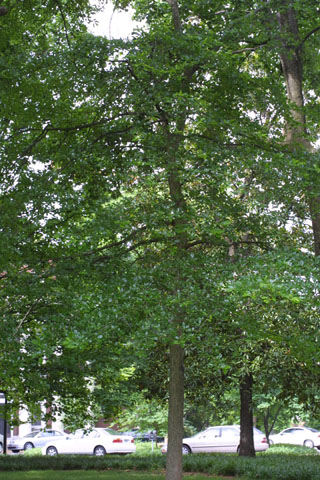 |  |  |  |
An individual instance of Nyssa sylvatica (blackgum)

Permanent unique identifier for this particular organism:
http://bioimages.vanderbilt.edu/vanderbilt/12-188
Notes:
You can find this relatively small tree near the southwest corner of Magnolia Circle.
Black gum leaves may be recognized by the fact that they are not very distinctive: they are simple, alternately arranged, with smooth margins. In the fall, they become noticeable as they become red with dark splotches. Black gum may be confused with persimmon, which has similar leaves. However, the leaf scar of black gum has three bundle scars, in contrast to persimmon which has a single, banana-shaped bundle scar. The bark of larger individuals of the two species are also quite different. Black gum's bark has vertical ridges, in contrast to the square plates of persimmon's bark. In the fall, black gum produces fleshy black fruits, although since the species is dioecious, only female individuals will have them.
Black gum is fairly common in uplands in this area. Its habitat is quite different from other Nyssa species which tend to grow in swamps and wetlands.
This tree is described on p. 79 of The Trees of Vanderbilt.
Black gum leaves may be recognized by the fact that they are not very distinctive: they are simple, alternately arranged, with smooth margins. In the fall, they become noticeable as they become red with dark splotches. Black gum may be confused with persimmon, which has similar leaves. However, the leaf scar of black gum has three bundle scars, in contrast to persimmon which has a single, banana-shaped bundle scar. The bark of larger individuals of the two species are also quite different. Black gum's bark has vertical ridges, in contrast to the square plates of persimmon's bark. In the fall, black gum produces fleshy black fruits, although since the species is dioecious, only female individuals will have them.
Black gum is fairly common in uplands in this area. Its habitat is quite different from other Nyssa species which tend to grow in swamps and wetlands.
This tree is described on p. 79 of The Trees of Vanderbilt.
 |  |
Load database and switch to thumbnail view
Use this stable URL to link to this page:
http://bioimages.vanderbilt.edu/vanderbilt/12-188.htm
This organism is a living specimen that is part of the Vanderbilt University Arboretum with the local identifier 1-583.
This particular organism is believed to have managedmeans of establishment.
This organismal entity has the scope: multicellular organism.
Remarks:Described in the 1994 Trees of Vanderbilt p. 79.
Identifications:
Nyssa sylvatica
Marshall
sec. Gleason Cronquist 1991
common name: blackgum
family: Cornaceae
Identified 2001-11-19 by Steven J. Baskauf
Location:
Vanderbilt University, Nashville, Davidson County, Tennessee, US
Click on these geocoordinates to load a map showing the location: 36.14312°, -86.79882°
Coordinate uncertainty about: 10 m.
Location of individual determined from GIS database.
Occurrences were recorded for this particular organism on the following dates:
2002-06-11
2002-05-14
2003-10-03
The following images document this particular organism.
Click on a thumbnail to view the image and its metadata.Load database and enable navigation by taxon and organism.






